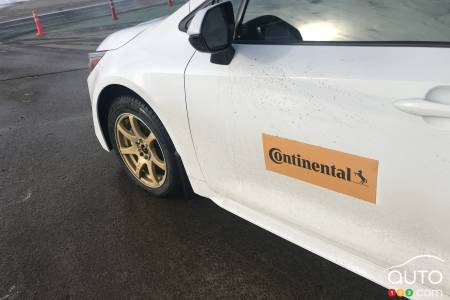German tire manufacturer Continental gave us the opportunity, in mid-February 2024, to test the UltimateContact Winter tire, its latest product in the winter tire segment, at Circuit ICAR in Mirabel, Quebec.
Continental teamed up for this product with major tire retail chain Canadian Tire, which obtained exclusive rights to the Ultimate Contact Winter.
Recall that in winter 2023, Canadian Tire had a similar partnership for the launch of the Motomaster Winter Edge II winter tire with South Korean manufacturer Hankook.
The difference this time is Continental is keeping its own name on the tire.
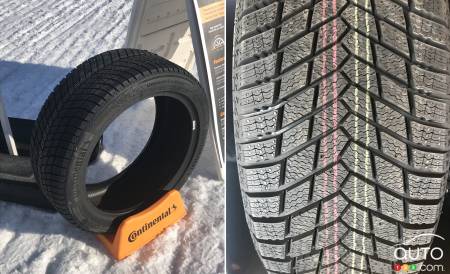
While many consumers are turning to the new trend of All Weather tires, other motorists - often those who drive more often on snowy or icy roads (as in Quebec, for example) - are sticking to tires specifically designed for winter driving. This is where a product like the Continental UltimateContact Winter comes in.
For passenger cars, crossovers and SUVs
The UltimateContact Winter is designed for passenger cars, crossovers and SUVs. At launch, it is available in 26 sizes for rims from 15 to 20 inches in aspect ratios from 40 to 65.
This new tire has only a directional tread without studs. Notably, it's also compatible with electric vehicles, which are heavier and more powerful. Its design therefore focuses on low rolling resistance and noise attenuation.
Of course, the new Continental displays the mountain silhouette symbol with the snowflake inside, proving its certification for driving in winter conditions.
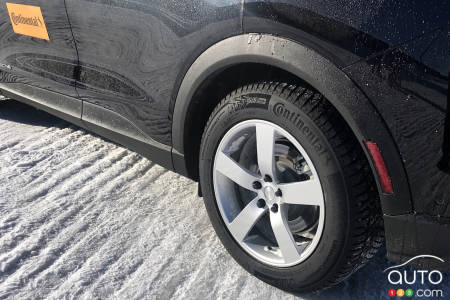
Among the technologies announced in the UltimateContact Winter's design, Continental specified the addition of +Silane, an additive in the rubber that should improve grip in slippery or wet conditions, but especially on ice.
The manufacturer also vaunted the PolarPlus+ technology, a tread compound that remains flexible in very cold temperatures.
Time to drive
Of course, all this sounds great on paper, but it still needs to be tested. To this end, Continental and Canadian Tire booked the facilities at Complexe ICAR in Mirabel and put together a program that would give a good overview of the newest Continental ties and its technologies and capabilities.
In addition, each test vehicle was paired with another similar one, but fitted with a competitor’s tires.

Following a brief product presentation, the first task for our group was to test the effectiveness of the Continental UltimateContact Winter on electric vehicles, in this case an all-wheel-drive Mustang Mach-e.
The first stage had us run on compacted snow, on which ICAR instructors had created a dynamic circuit with orange cones reproducing slalom and braking exercises on snow.
The competing product was a top-quality American tire that performed very well, we had to say. However, the UltimateContact Winter did very well against its rival. We even rated it slight ahead of it, if only because of its design more suited for electric vehicles, so stiffer and better adapted to lateral variations.
Incidentally, the instructors asked us not to disable the driving aids, so that we could better evaluate the Continental tires as if we were regular drivers.
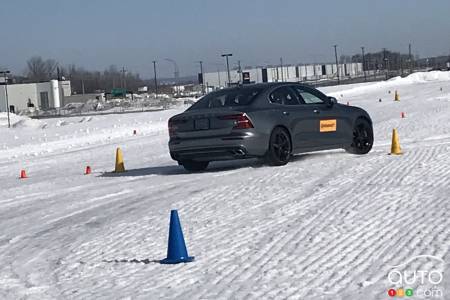
For stage two, we set out to evaluate Continental Tires mounted on a Volvo S60 T6, an AWD combustion -engine car. The other, “control” Volvo was fitted with French tires.
The short circuit we drove on was icier than the previous one, making comparison more difficult. With the Volvo's power regulated by traction control, it wasn’t quite as easy for us to negotiate tight, very short corners, but some hard braking proved that, in terms of grip, the Continental could outperform its competitor on both snow and ice.
For the next stage, the ICAR instructors had prepared a little surprise for us: driving a rally car on the stock-car track part of the facility, designed more for speed. The Subarus used for this exercise were genuinely sporty cars fitted with General Tire tires with special studs.
Note that General Tire is also part of the Continental tire family.
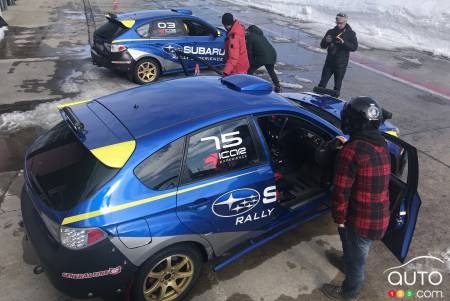

The exercise enabled us to learn a little more about performance driving on the oval track, slightly modified for the purpose. Its surface was also sufficiently damaged to make driving both more difficult and more instructive. Naturally, the specialized instructors were on hand to show participants a little more, especially when it came to gliding.
Finally, our fourth exercise was certainly the most instructive. ICAR's instructors had chosen all-wheel-drive Toyota Corolla hybrids, fitted with Continental UltimateContact Winter tires, or else highly reputed Japanese tires for comparison.


This circuit used portions of ICAR's track with relatively dry pavement, but on which snow had been added in the curves. Each participant had to negotiate the circuit, which also featured puddles produced by melting snow. Essentially, the conditions were typical of city streets in winter.
This time, the difference was even more obvious. On every lap, the cars fitted with Continental tires had more grip than those with the competing high-end tires.
Pushing the machine (at an equivalent moderate speed), one of those latter cars actually got away from me in one of the curves, the front end giving way before I could regain control. A few seconds later, in another curve, it was the rear's turn to chase. Clearly, the Continental allowed us to be a little more aggressive.
Based on this day, the Continental UltimateContact Winter is worth considering when the time comes to equip your vehicle with its next winter tires.
This new Continental winter tire has been on the market since the fall of 2024.
